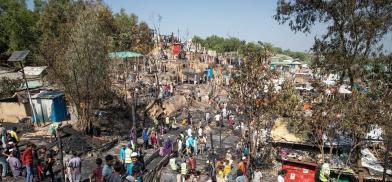Between flames and the future: Seeking practical and sustainable solutions for the Rohingya refugees in Bangladesh
Unfortunately, the repatriation of the Rohingya refugees might not be a feasible option, given the current circumstances. They have already been in the camps since 2017 with little done. The need of the hour is to devise a long-term solution for their integration into the host society, and assimilation seems to be a more sustainable answer than repatriation

The Rohingya refugee camps in Bangladesh have been witnessing a frightening surge of fires, with each one leaving another scar on the community. These recurring tragedies have not only caused substantial damage to the makeshift shelters but have also impacted the lives of hundreds, if not thousands, of Rohingya refugees.
One such incident occurred on 24 April 2023 at the Chakmarkul Rohingya Camp in Teknaf of Cox's Bazar, leaving 239 people grappling with its aftermath (Relief Web). This, unfortunately, is not an isolated incident but one among a series of fires that have become a distressingly regular occurrence within the camps. With fires breaking out with such alarming frequency, the urgency to find sustainable solutions for the Rohingya refugees has become imperative.
The devastation experienced by the Rohingya community is unprecedented. Just to put things into perspective, let's take a brief look at the reported fires in the camps in recent times:

Mere relocation won't help
According to a report by the Bangladesh defense ministry, from January 2021 to December 2022, there were 222 fire incidents, including 60 cases of arson in the camps (BBC March 2023).
Additionally, gas leakages have emerged as another looming threat, further escalating the dangers faced by the Rohingya living in these makeshift shelters.
The Rohingya have resided in these camps for almost six years, and with each passing day, the need for safer and more sustainable living conditions grows increasingly urgent. While international efforts are being made to relocate the refugees to safer locations, we must reflect on how we can improve their conditions right where they are. The question, then, is not just about providing immediate relief but about envisioning a future where the refugees are not just surviving but thriving.
It is clear that a more long-term, sustainable solution needs to be devised to improve the living conditions and safety of the Rohingya refugees. Transparency in aid distribution and its effective use are key elements in the path towards betterment.
Merely relocating the Rohingya to different parts of the country might not be the optimal solution, as it overlooks their fundamental human rights to live peacefully and securely. A more viable alternative could be assimilation into the host society.
Through collaborative efforts between the government and NGOs, education and vocational training could be provided to the Rohingya, empowering them to contribute to the economy and society while reducing their dependence on aid. Just a month ago, the US provided an $23.8m for Rohingya refugee food aid (Link)
Giving Rohingyas a chance
The NGOs and international bodies need to join hands in providing necessities, education, and vocational training while ensuring transparent and effective aid use. Only through such coordinated efforts can we offer the Rohingya people a chance to live peacefully and free from chaos. This shift from mere survival to the possibility of thriving would not just alleviate their current conditions.
Fires are boundaryless, with the potential to surge unpredictably, causing immense destruction. They threaten not only the lives and homes of the inhabitants of Cox's Bazar and the Rohingya refugees but also pose a significant risk to the surrounding environment.
Therefore, it is imperative to establish comprehensive fire prevention and response systems, to safeguard both the human and natural ecosystems in and around the refugee camps. This includes bolstering early warning systems, investing in fire-fighting infrastructure, and promoting education and awareness among the camp's residents regarding fire safety practices.
Through such collective and proactive measures, we can minimize the risk and impact of these devastating fires, ensuring a safer and more sustainable future for all residents and the precious environment that cradles them.
(The author is a Bangkok-based Bangladeshi researcher who works on the subject of refugee migration and rehabilitation. He also explores the role of social media in society and regional connectivity in Asia. Views are personal. He can be contacted at safenroy@gmail.com)
casino en ligne
You actually explained it very well.
casino en ligne France
Thanks. A good amount of tips.
casino en ligne fiable
Regards! Plenty of knowledge.
casino en ligne France
Awesome stuff Appreciate it!
casino en ligne France
Cheers! Lots of advice!
casino en ligne
Thanks, I like this.
casino en ligne francais
You expressed this exceptionally well.
casino en ligne
You have made the point.
casino en ligne fiable
You actually stated it wonderfully!
casino en ligne










Post a Comment